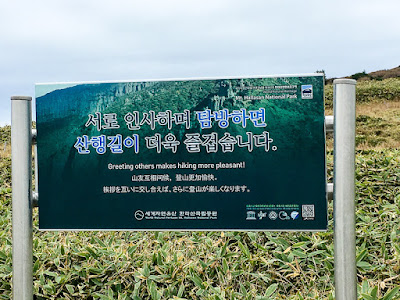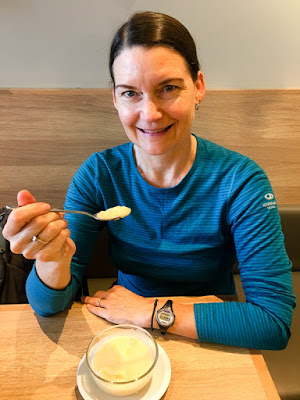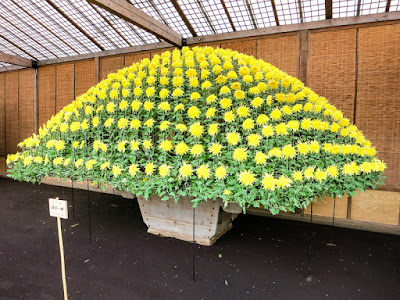
Bada Sory means
sound of the sea in Korean.

We had a short but nice visit. Mihee shared this awesome photo from her recent trip to Canada. She's so much fun!

We went back to Bada Sory to have dinner. Mihee was so kind, she gave us these beautiful miniature Korean ceramics called selamig dojagi (세라믹 도자기).

This is Mihee's husband who is the head chef at Bada Sory. We were happy they remembered us and that we had a chance to reconnect.

We love the Korean version of sashimi called hoe that Bada Sory features. The centerpiece of our meal was a platter of amazingly fresh, raw fish.

The fish can be eaten with wasabi (hot mustard) and soy sauce. Their wasabi was very fresh which made it even hotter than usual.

Another way to eat hoe is with the Korean sauce of sesame, ginger and scallions.

The final dish of the meal was a fish soup. Made with the bones of the fish we had eaten for dinner, the soup was spicy and flavorful.

Coffee culture has arrived in South Korea. We found a hip cafe called
Matin set back from a busy street.

Pete enjoyed a pour-over and Kristina had an Americano.

We liked their message on the door looking out to the courtyard.

We left Busan to visit Jeju Island. We stayed in a hotel with great views of the sea, especially at sunset.

One of the first things we did on Jeju was eat Korean barbecue. In front of Kristina are all the sauces.

Pete worked the grill, turning pieces of pork shoulder, onions and mushrooms until they were cooked.

Here’s how we ate: the sauces are spread on lettuce or perilla leaves, then kimchi, grilled onions and pork are layered in, and finally it’s rolled up and popped into our mouths. Yum!

This was our first time to visit Jeju. We rented a car to get around the island, a cute little Kia Morning.

Jeju Island is volcanic, and the last eruption was 300,000 years ago. We hiked the Yeongsil Trail on the Mt Hallusan volcano. Behind Pete the rock formations are called
500 Disciples of Buddha.

We liked this sign, "Greeting others makes hiking more pleasant!"

We exchanged greetings with the other hikers, "
Anasayo", which means hello. Koreans love to hike and their trails are fantastic.

These rocks are clearly volcanic, and we saw lots of them all over the island.

This photo of Kristina on the descent shows the variation in the trail: some steps, some rocks, some dirt. The hike was the equivalent of 136 flights of stairs, and our calves were sore for a few days afterwards.

This time of year the color in the landscape comes from the changing leaves and ripening berries.

We saw a few trees with leaves starting to change to fall colors.

We visited the Manjanggul Lava Tube, a UNESCO World Heritage Site.

It was cold and wet inside the cave.

The cave had lit paths for about one kilometer, so we walked out. Pete is in front of
lava toes, where the lava had flowed until it stopped.

This lava raft is about the shape of Jeju Island and is named
The Tortoise.

At the end of cave was a 27 meter lava tube, the longest known lava tube in the world. People were taking selfies with the lava tube in the background.

As we explored Jeju, we saw lots of these lava rock sculptures. We learned they are called
dol hareubangs, rock seniors that were first created in the 18th century to offer protection from demons. Today Jeju Island is the most common South Korean honeymoon spot, so perhaps this is why the dol hareubangs are now thought of as fertility gods.

We visited Sanbanggulsa, a Buddhist temple that also had dol hareubangs.

This was the view inside the temple.

We liked seeing 1,000 Avalokitesvaras protecting the Buddha.

Through the prayer wheels you can see the southern coast of Jeju.

Next we flew to Chiang Mai, Thailand for ten days. After all our traveling around in Japan and South Korea, we were ready to stay in one place for awhile. This is the entrance to our favorite restaurant Krua Phech Doi Ngam.

Kristina's pink t-shirt matches the elephants.

We had found Krua Phech Doi Ngam earlier this year through a New York Times interview with Andy Ricker. He recommended it as one of the best authentic northern Thai cuisine restaurants. What a feast!

Krua Phech Doi Ngam has an extensive menu of more than 130 dishes. This is
pla tub tim tod sa mun prai, deep-fried whole tilapia fish with crispy Thai herbs like kaffir lime leaves and lemongrass.

We could even eat the bones because the fish had been perfectly deep-fried. The fried pork skin on the plate in front of the fish was also the best we've ever eaten.

This is
yum neam, fermented pork salad.
We left Chiang Mai and flew to Bangkok, mostly for medical tourism. While in Bangkok we ate durian fruit. This photo shows the spiky whole fruits, and the edible insides packaged for sale.

Durian is definitely an acquired taste, and it took us a few tries to like it. People who hate it say it smells like sewage, or worse. The fruit is so stinky that it's not allowed on the Bangkok subway.

But now we are definitely hooked. We tried durian a few ways: durian ice cream, dried durian, and fresh durian (as pictured). If you're a durian fan, check out this
durian blog.

We used to only eat mango sticky rice for dessert, but not any more! Here Kristina is enjoying fresh durian with sticky rice.

We went for a late lunch at Nahm restaurant. Their orchids at the entrance were lovely.

We had the place almost to ourselves.

Kristina is sipping ginger beer as she eyes the appetizers.

One of our favorite dishes was the pork, lobster, ginger and Thai citron in betel leaf.

We noticed a subdued atmosphere in Thailand during our visit because the country is in mourning for their beloved King. Photos of King Bhumibol Adulyadej were displayed everywhere in Bangkok.

Because he had recently passed away, the King's photos were surrounded by white flowers and black and white draperies. Since we had just heard the US election results, the somber and mournful atmosphere resonated with us.

Most Thais were wearing black or white clothing, the colors of mourning in Thailand. Those who weren't would often have a black ribbon pinned to their sleeve.

We met our friend Eric for dinner at restaurant named
Tamnak Isan. Eric has been living and working in Bangkok for a year and a half, and we are glad that we've been able to visit him three times.

Medical tourism is very affordable in Bangkok, and we are happy to have clean teeth and clean bills of health. We liked Tamnak Isan restaurant so much that we went back on our last day.

Perhaps because we knew we were heading to Japan we sought out these matcha softos. This time the green tea soft serve was served in a fish cake cone called
taiyaki.

It was interesting to leave hot, humid Thailand and to arrive in Tokyo where it looked and felt like fall. Walking near our hotel in Shibuya we came across Harajuku featuring Hokkaido ice cream, so we waited in line to try it.

The ice cream was so rich and creamy! This woman was filming her entire experience there. Notice the Hokkaido cow on the glass behind her.

Tokyo is filled with lots of hipster cafes that feature excellent coffee, so each day we tried a new place. This is Artless Coffee.

Pete tried the Columbian coffee while the barista made roasted tea for Kristina.

We read about where to see the changing leaves in Tokyo. First we went to Meiji Shrine, a Shinto shrine not far from our hotel.

We visited on a Saturday, and the grounds were crowded.

It was our first time to visit, and we found the rebuilt shrine beautiful.

We noticed lots of families dressed in traditional clothing.

This little girl was doing her best to a flash peace sign as she posed for photos.

There was a wedding at Meiji Shrine while we were there. The bride is dressed in white with the big hat.


Apparently you don't need to be related to Emperor Meiji in order to get married at the shrine.

We enjoyed seeing all the costumes in the ceremonial procession.

Pete was craving a hamburger, so we went to Great Burger.

His beef burger with avocado and jalapeños hit the spot.

Another day we had to have tasty ramen!

We went for coffee at The Roastery. The temperatures were in the low 20s C so the coffee warmed us up.

The Costa Rican coffee was quite good, and we liked that the information card included the names of the coffee farmers!

We visited
Icho Namiki, Ginkgo Avenue in Meiji Jingu Gaien Park. Kristina is eating a piping hot sweet potato as she strolls through the lovely trees.

The ginkgo trees were turning yellow but weren't yet at peak fall color.

We liked seeing that some streets were closed to vehicle traffic on Sunday, making it easy for cyclists and walkers to enjoy themselves.

This is the inside of Teppen restaurant, a mostly yakitori place in Shibuya.

We had visited in 2015 for Kristina's birthday. They didn't remember us, but they give everyone a warm welcome and we had a fun time. And the yakitori chicken skewers were outstanding

This is the owner, she is always smiling.

She added to our bill 100 smiles at no charge!

We went to the Shinjuku Gyoen National Garden. Lots of families were enjoying a sunny Sunday in the garden.

We saw some nice fall foliage here too.

There was a chrysanthemum show at the garden that was pretty spectacular. This is an
okukuri, 1,000 bloom chrysanthemum that takes a year to train into this orderly shape.

Kristina is next to
kengai, cascade style flowers that are trained to look like wild chrysanthemums flowering on a cliff.

These chrysanthemums had centers that looked like woven baskets.

We indulged in delicious gelato: mango, cassis, bitter coffee and chocolate.

We had coffee while overlooking the famous Shibuya crossing. Because it wasn't rush hour, the crowds looked pretty small, but it was still fun to watch people streaming through the intersection when the light turned green.

The shop had these delicious soufflé pancakes that fueled us for a walk in the Koishikawa Korakuen Gardens.

We love Japanese gardens, with their thoughtful, manicured beauty.

We are in front of Engetsu-kyo, full moon bridge.

So named because of the full circle created by the arch and its reflection.

The garden is built in a "circuit style" and has wonderful stone paths throughout that were fun to explore.

The island in the center, called the Inner Court, was originally connected to Mito Komon's residence. He was the founder of the garden.

The garden is almost 400 years old. It was interesting to see the nearby modern buildings surrounding the garden, and to think about what it must have been like as a private garden in the Edo period.

This tree with its flaming red leaves was on an island in the center of the largest pond.

While we walked we reflected with gratitude on how fortunate we feel to have made this trip. We arrived in Hokkaido with our friends Paul and Julie in mid August. We rode the length of Japan on our tandem bike. We traveled around South Korea with Kristina's folks. And then we finished up with visits to Thailand and Bangkok.

It's been a fantastic trip! Next we fly back to California to spend the holidays with family and friends.


















































































































